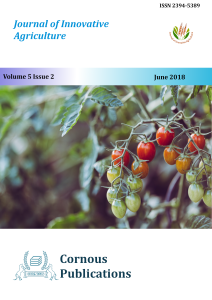
Journal of Innovative Agriculture
Peer Reviewed Open Access Journal
ISSN: 2394-5389 NAAS: 4.05
Submit Manuscript
Peer Reviewed Open Access Journal
ISSN: 2394-5389 NAAS: 4.05
Submit ManuscriptThe effect of seed dressing chemicals on cotton seedling stand establishment against soil borne diseases and yield were assessed in field experiment conducted at Cotton Research Station Junagadh Agricultural University Junagadh during 2013, 2014 and 2015. Results of three years pooled data indicated that all fungicidal treatments increase the germination as compare to control. Maximum seed germination percent was recorded to given seed treatment of carboxin 37.5% + thiram 37.5% DS @ 4.5 g/kg seed against seedling diseases of cotton Rhizoctonia solani and Fusarium sp. The pooled mortality percent was significantly minimum (5.70%) recorded in treatment Carboxin 37.5% + Thiram 37.5% DS, 4.5g/kg seed, followed by Carboxin 37.5% + Thiram 37.5% DS, 3.5g/kg seed (7.02%) as compare to control(17.70%). The significantly maximum seed cotton yield of 1754 kg/ha was recorded in treatment of Carboxin 37.5% + Thiram 37.5% DS, 4.5g/kg seed, followed by Carboxin 37.5% + Thiram 37.5% DS, 3.5g/kg seed (1712kg/ha) as compare to control1205 kg/ha seed cotton yield. Economical point of view the seed treatment of Carboxin 37.5% + Thiram 37.5% DS(Vitavax power) @ 3.5g/kg seed was found effective in reducing the mortality percent of soil borne diseases & highest CBR (1:261.3) with net return of Rs. 21,212/ha. The most important variable in these experiments was maximum germination percent so that farmer can maintain plant population of cotton.
Cotton, seedling, seed dressing chemicals, seedling rot, root rot and wilt
Chaudhary, D.R. 2002. Organic farming: An overview. Farmers Forum, 2(4): 7-9.
Das, S.K. 2013. Integra integrated nutrient management using only through organic sources of nutrients. Popular Kheti, 1(4): 121-126.
Deivamani, M. and M. Muthamilan. 2016. Morphological, Physiological and Biochemical characteristics of Xanthomonas campestris pv. campestris by black rot of cabbage. Journal of Innovative Agriculture, 3(1), 10-18.
Karup, B.S., R. Puspakumari and S.R. Issac. 2007. Enhancing nitrogen use efficiency in Okra with nitrification inhibitor. Vegetable. Science, 24(1): 10-12.
Kumarasamy, K. 2002. Organic farming – Relevance and prospects. Indian Society Soil Science News letter, p. 12.
Makkar, H.P.S. and K. Becker. 1997. Jatropha curcas toxicity, identification of toxic principle(s). In: 5th International symposium on poisonous plants. May 19-23, San Angelo, Texas, USA. p. 30.
Natarajan, S. 1990. Standardization of nitrogen application of chilli grown under semi dry condition. South Indian Horticulture, 38(6): 315-318.
Rawat, A.K. 2002. Organic farming. In: CAS training on organic agriculture – a paragon for sustainability, held at JNRVV, Jabalpur, March 26 – April 15th, 2002. pp. 1-6.
Sankaranarayanan, K. 2004. Nutrient potential of organic sources for soil fertility management in organic cotton production. In: www.cicr.org.in. pp: 1-6.
Shaikh, S. and A. Patil. 2013. Production and utilization strategies of organic fertilizers for organic farming: an eco-friendly approach. International Journal of Life Sciences and pharma Research, 3 (2): 1-5.
Sharma, S.K. 2002. A synoptic view of linkage of organic farming with reproductivity and sustainability of India. In: CAS training on organic agriculture – a paragon for sustainability, held at JNRVV, Jabalpur, March 26 – April 15th, 2002. p. 29.
Yadav, R.L., K. Prasad, K.S. Gangwar and B.S. Dwivedi. 1998. Cropping systems and resource use efficiency. Indian Journal of Agricultural Sciences, 68: 548-558.
